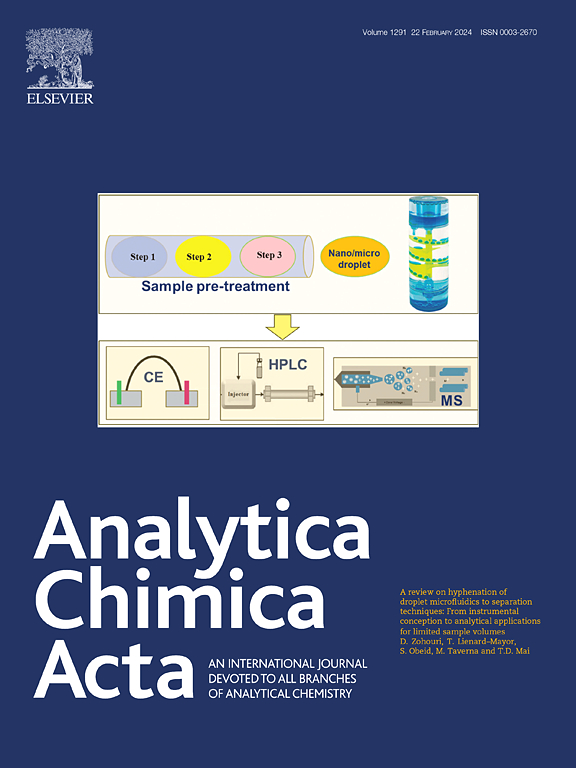用于高性能手性分离的Pepsin@COF纳米生物混合平台的简易制造
IF 6
2区 化学
Q1 CHEMISTRY, ANALYTICAL
引用次数: 0
摘要
酶具有广泛的手性识别能力,前景广阔,但受到稳定性问题的限制。共价有机框架(COFs)具有高表面积、多孔结构和生物相容性,为酶的固定化提供了理想的平台。然而,由于酶分子的大尺寸与COFs的孔径不匹配,加上固定化过程中的构象干扰,以及传统酶基手性固定相(CSPs)制备复杂、效率低、稳定性差,阻碍了酶的高手性选择性在脱羧分离中的应用。结果引入绿色合成策略,克服了传统enzyme@COF合成方法的局限性,使胃蛋白酶易于锚定在具有小孔隙的TpPa-1上。原位包封方法具有高酶载量和优异的稳定性,这使得Pepsin@TpPa-1具有显著的增强手性选择性的潜力。受原位概念的启发,开发了一种创新的色谱柱制备技术,通过直接在毛细血管内生长Pepsin@TpPa-1,创造出具有高密度手性识别位点的毛细管电色谱开管柱(OT-CEC),实现了多种手性药物的高效分离,包括β阻断剂,酯酶抑制剂等类型。从分子水平揭示胃蛋白酶复杂的手性识别机制,探索Pepsin@TpPa-1活性与手性选择性的正相关关系,为设计高性能手性识别平台提供理论支持。意义:本研究首次将酶- cof复合材料应用于CEC csp,克服了低酶载量和不稳定性等挑战。这种酶基CSP促进了手性药物的广泛分离。该研究为胃蛋白酶的识别机制以及其活性与手性选择性之间的关系提供了新的见解。此外,高度稳定的手性纳米生物混合分离平台为OT-CEC的CSP开发引入了开创性的研究范式。本文章由计算机程序翻译,如有差异,请以英文原文为准。


Facile fabrication of tailored Pepsin@COF nanobiohybrid platform for high-performance chiral separation
Background
Enzymes, with their broad chiral recognition capabilities, are promising but limited by stability issues. Covalent organic frameworks (COFs), with high surface area, porous structure, and biocompatibility, offer an ideal platform for enzyme immobilization. However, the non-matching between the large size of enzyme molecules and the pore size of COFs, along with conformational disturbances during the immobilization process, as well as the complex preparation, low efficiency, and poor stability of traditional enzyme-based chiral stationary phases (CSPs), hinders the application of highly chiral selectivity of enzyme in enatioseparation.
Results
A green synthesis strategy is introduced to overcome the limitations of conventional enzyme@COF synthesis, enabling the facile anchoring of pepsin onto TpPa-1 with small pores. The in-situ encapsulation approach facilitates high enzyme loading and excellent stability, which lead to the remarkable potential of Pepsin@TpPa-1 for enhanced chiral selectivity. Inspired by the in-situ concept, an innovative chromatographic column preparation technique is developed by growing Pepsin@TpPa-1 directly within capillaries, creating an capillary electrochromatography open-tube column (OT-CEC) with high-density chiral recognition sites, achieving efficient separation of diverse chiral drugs, including β-blockers, esterase inhibitors, and other types. The complex chiral recognition mechanism of pepsin is revealed at the molecular level, and the positive correlation between Pepsin@TpPa-1 activity and chiral selectivity is explored for offering theoretical support for designing high-performance chiral recognition platforms.
Significance
This study represents the first application of enzyme-COF composites in CEC CSPs, overcoming challenges like low enzyme loading and instability. This enzyme-based CSP facilitated the extensive separation of chiral drugs. A novel insight is provided into the recognition mechanism, as well as the relationship between pepsin's activity and its chiral selectivity. Furthermore, the highly stable chiral nanobiohybrid separation platform introduces a pioneering research paradigm for CSP development in OT-CEC.
求助全文
通过发布文献求助,成功后即可免费获取论文全文。
去求助
来源期刊

Analytica Chimica Acta
化学-分析化学
CiteScore
10.40
自引率
6.50%
发文量
1081
审稿时长
38 days
期刊介绍:
Analytica Chimica Acta has an open access mirror journal Analytica Chimica Acta: X, sharing the same aims and scope, editorial team, submission system and rigorous peer review.
Analytica Chimica Acta provides a forum for the rapid publication of original research, and critical, comprehensive reviews dealing with all aspects of fundamental and applied modern analytical chemistry. The journal welcomes the submission of research papers which report studies concerning the development of new and significant analytical methodologies. In determining the suitability of submitted articles for publication, particular scrutiny will be placed on the degree of novelty and impact of the research and the extent to which it adds to the existing body of knowledge in analytical chemistry.
 求助内容:
求助内容: 应助结果提醒方式:
应助结果提醒方式:


